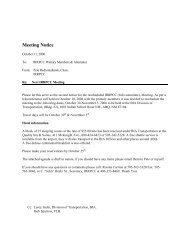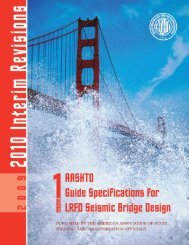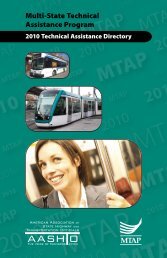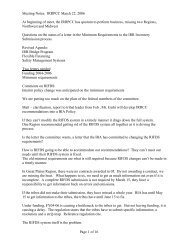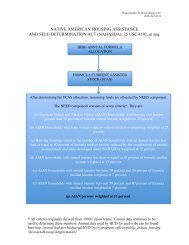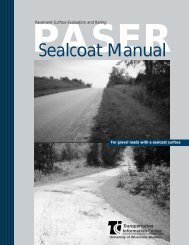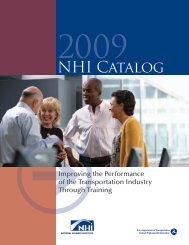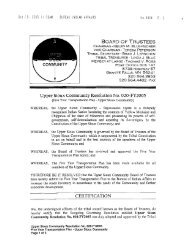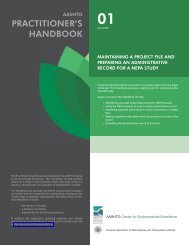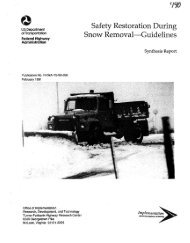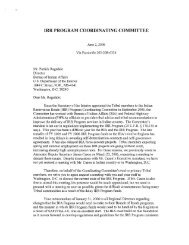Safety in Welding, Cutting, and Allied Processes
Safety in Welding, Cutting, and Allied Processes
Safety in Welding, Cutting, and Allied Processes
You also want an ePaper? Increase the reach of your titles
YUMPU automatically turns print PDFs into web optimized ePapers that Google loves.
ANSI Z49.1:1999<br />
subjected <strong>in</strong> service, but <strong>in</strong> no case less than 300 psi<br />
(2070˚kPa). Oil-free air or an oil-free <strong>in</strong>ert gas shall be<br />
used for test<strong>in</strong>g.<br />
10.6.7 Devices. Only approved devices as def<strong>in</strong>ed <strong>in</strong><br />
2.1 shall be used <strong>in</strong> oxyfuel gas systems.<br />
10.6.7.1 The use of suitable approved flashback<br />
arrestors shall be permitted to be used.<br />
10.7 Pressure-Reduc<strong>in</strong>g Regulators<br />
10.7.1 Approval. Only approved pressure reduc<strong>in</strong>g<br />
regulators, as def<strong>in</strong>ed <strong>in</strong> 2.1, shall be used.<br />
10.7.2 Designated Service. Pressure reduc<strong>in</strong>g regulators<br />
shall be used only for the gas <strong>and</strong> pressures for which<br />
they are labeled. The regulator <strong>in</strong>let connections shall comply<br />
with ANSI/CGA St<strong>and</strong>ard V-1, Compressed Gas Cyl<strong>in</strong>der<br />
Valve Outlet <strong>and</strong> Inlet Connections.<br />
Regulators shall not be <strong>in</strong>terchanged among designated<br />
gas services.<br />
E10.6.7 When an approved device such as a hose check<br />
valve or flash-back arrestor is used <strong>in</strong> an oxyfuel gas weld<strong>in</strong>g<br />
<strong>and</strong> cutt<strong>in</strong>g torch system, the device should be used<br />
<strong>and</strong> ma<strong>in</strong>ta<strong>in</strong>ed <strong>in</strong> accordance with the manufacturers <strong>in</strong>structions.<br />
Refer to CGA Pamphlet E-2, St<strong>and</strong>ard Hose<br />
Connection Specifications.<br />
E10.6.7.1 Flashback arrestors can provide a certa<strong>in</strong><br />
measure of protection aga<strong>in</strong>st the hazards of flashback.<br />
To ma<strong>in</strong>ta<strong>in</strong> this protection <strong>and</strong> to ensure that they have<br />
not become damaged or <strong>in</strong>operative dur<strong>in</strong>g use, a rout<strong>in</strong>e<br />
<strong>in</strong>spection program should be followed as specified dur<strong>in</strong>g<br />
use. Also, a regular <strong>in</strong>spection program should be followed<br />
as specified <strong>in</strong> the <strong>in</strong>structions provided by the<br />
manufacturer.<br />
Many years of field experience has shown various oxyfuel<br />
gas torches to be reliable <strong>and</strong> safe apparatus when<br />
operated <strong>in</strong> accordance with <strong>in</strong>structions recommended by<br />
the manufacturer. Under certa<strong>in</strong> circumstances, the users<br />
failure to follow these <strong>in</strong>structions can cause the backflow<br />
(reverse flow) of unwanted gas <strong>and</strong>/or flashback <strong>in</strong>to the<br />
upstream equipment.<br />
E10.7.1 Refer to CGA E-4, St<strong>and</strong>ard for Gas Regulators<br />
for Weld<strong>in</strong>g <strong>and</strong> Cutt<strong>in</strong>g.<br />
E10.7.2 Contam<strong>in</strong>ation can lead to explosions <strong>and</strong> fire.<br />
10.7.3 Inspection Before Use. Union nuts <strong>and</strong> connections<br />
on regulators shall be <strong>in</strong>spected before use to<br />
detect faulty seats which may cause leakage when the regulators<br />
are attached to cyl<strong>in</strong>der valves or hoses. Damaged<br />
nuts or connections shall be replaced.<br />
10.7.4 Oxygen Gauges. Gauges used for Oxygen service<br />
shall be marked USE NO OIL.<br />
10.7.5 Oxygen Regulators. Regulators shall be dra<strong>in</strong>ed<br />
of oxygen before they are attached to a cyl<strong>in</strong>der or manifold,<br />
or before the cyl<strong>in</strong>der valve is opened (see also<br />
10.8.4.4 <strong>and</strong> 10.8.4.11). Oxygen cyl<strong>in</strong>der or manifold<br />
valves shall always be opened slowly (see 10.8.4.3 <strong>and</strong><br />
10.8.4.4).<br />
E10.7.5 The regulator attached to a cyl<strong>in</strong>der can be<br />
dra<strong>in</strong>ed of oxygen by momentarily open<strong>in</strong>g <strong>and</strong> then clos<strong>in</strong>g<br />
the downstream l<strong>in</strong>e to the atmosphere with the regulator<br />
adjust<strong>in</strong>g screw engaged <strong>and</strong> the cyl<strong>in</strong>der valve<br />
closed. The cyl<strong>in</strong>der valve is then opened slowly. The<br />
oxygen cyl<strong>in</strong>der or manifold outlet connection should be<br />
wiped clean with a clean cloth, free of oil <strong>and</strong> l<strong>in</strong>t, <strong>and</strong> the<br />
cyl<strong>in</strong>der valve cracked before connect<strong>in</strong>g the regulator<br />
(see 10.8.4.3).<br />
25



